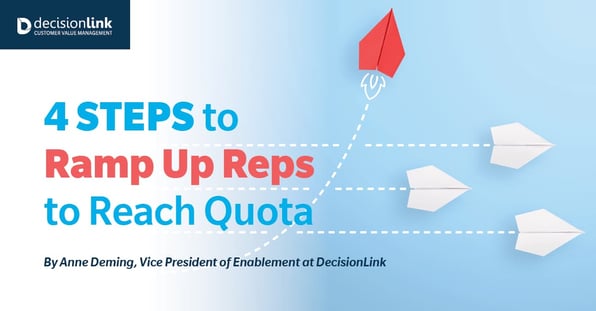4 Steps to Ramp Up Reps to Reach Quota

Sales is a noble yet challenging profession. And in the current work environment, practicing your craft can be downright exhausting. However, effective onboarding and training keeps life manageable (and goals attainable) for your sales reps. The key is to simplify your approach. Starting a fresh sales role is like learning a new language — easy to understand when shared in small, frequent chunks of knowledge. With constant iteration. We use these approaches at DecisionLink yielding powerful results.
1. Too much information is a bad thing
First things first: NO DAY 1 BOOTCAMPS. Companies have tried 12- hour workdays with week-long boot camps with intensive, overwhelming training. Don’t forget about the nonstop PowerPoint presentations, only to be interrupted with introductions and maybe a quick lunch break. Maybe. This approach is wasteful and irrelevant, and if you serve donuts or pizza, you’re almost certain to put your new hires to sleep. I find these sessions to be utterly useless. Your energetic, optimistic new hires have absolutely no context for the vast well of information being thrown at them. There is one exception…a few months into the job, there is tremendous value in a seller’s bootcamp because your employee will then have enough experience in the role to ask relevant questions to fill any gaps in knowledge, expertise, or content. So please, keep things very simple at the beginning of an onboard experience for the best shot at knowledge retention.
2. Are you over-digitizing the process?
The sea of sales technology today is off-putting. Too many systems can actually be a roadblock to success. I would guess most of your quota-attaining reps try to connect with customers in-person (but are forced to spend a lot of time with hands on the keyboard). So, if all of your training is about process and flowcharts with calculations and tests, then you are missing the opportunity to teach your company’s success story. People actually like stories and they tend to remember them. I admit - this is a tricky line to walk because you need a balance of accurate sales processes, but enough space to allow selling & storytelling to happen. We are not machines; yet I’ve seen a great many training plans focus only on the technical ins-and-outs of inspection, like how opportunities are tracked, drop-down fields, and exception procedures. How on earth will a sales rep remember all of this? Yes, technology can support the process, but when it becomes overwhelming, you’re defeating the purpose. Ask your current reps for an honest assessment. They’ll tell you what’s worthwhile and what they need. And take this into consideration: if you are the sales rep who refuses to enter a MEDDIC field in Salesforce but somehow manages to close a deal or two — you are part of the problem. Do your peers a solid and take care of the administrative part of your job. Chances are you are the reason management is asking for greater inspection. Everyone wants to be selling but if you don’t have good opportunity hygiene it invites intense scrutiny and takes time away from prospecting.
3. Simplify the script
The philosophy of bootcamps is to empower salespeople to create their own script. But the truth is: they’re not ready right out of the gate. They need you to give them the words. The exact words. A super simple script. Stick to the basics because the reality is, learning how to sell a new product is like learning a new language. We wouldn’t try to learn French by reading Les Miserables. We’d start by saying ‘’bonjour’’, or ‘’hello’’ in English. Begin with the most basic conversational components — the easiest way to engage sales while showing immediate progress.
4. Focus on value, not features
Keep your practice scripts centered on a single benefit. Just one. Ask and answer in the fewest number of words possible. What would a customer find useful right away? What is the value to their business? You want to make sure the conversation that a new hire has with a prospect actually matters. This is a powerful way to set up the human connection. It doesn’t have to be perfect but it does have to be meaningful and simple. And it has to launch the conversation.
When value added selling is utilized in the right way it leads to better conversions, renewals, cross, and up-selling rates, increased customer lifetime value, maximized ROIs, and more. The thought process may seem obvious, but it’s always important to polish your approach. In next week’s blog in this series, I have four final tips to help elevate your sales reps’ efforts to focus on value to hit their numbers time and time again.
Bio

Anne Deming is the Vice President of Enablement at DecisionLink. She has spent the last 15+ years in software sales with responsibilities ranging from account management and has managed special projects for CEOs, sales enablement, and sales engineering. Learning from the experience of winning and losing in each quota-carrying role, Anne develops training that truly matches the job reality and empowers entire sales organizations to level up for success.

 ValueCloud
ValueCloud
.png?width=118&height=76&name=Rectangle%20(3).png) ValueCloud Ignite
ValueCloud Ignite
.png?width=92&height=92&name=Rectangle%20(4).png) Free Assessment
Free Assessment
.png?width=100&height=100&name=Rectangle%20(5).png) Watch a Demo
Watch a Demo
.png?width=82&height=96&name=Rectangle%20(6).png) Value Calculator
Value Calculator

.png?width=62&height=51&name=Group%2010%20(1).png) Marketing
Marketing
 Sales
Sales
 Customer Success
Customer Success
 Engage Prospects
Engage Prospects
 Win Deals Faster
Win Deals Faster
 Retain Customers
Retain Customers
.png?width=62&height=62&name=Rectangle%20(8).png) Adopt and Scale
Adopt and Scale
.png?width=54&height=54&name=Rectangle%20(9).png) Cybersecurity
Cybersecurity
 Healthcare
Healthcare
.png?width=54&height=54&name=Rectangle%20(10).png) IT & Software
IT & Software




